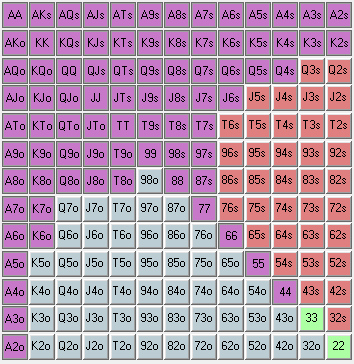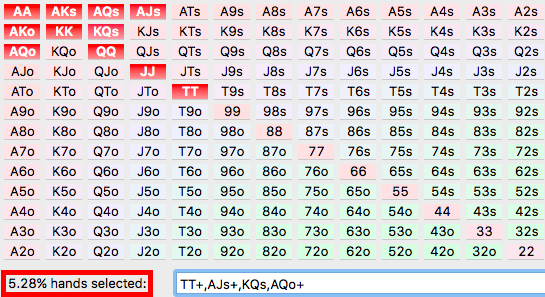Big Blind Defending Range
In the passive days of early poker, this was much less of an issue. You could call raises pre-flop from just about any position on the table without fear of having to put a ton more money intothe pot thanks to a later position re-raise.
Defending the Big Blind. Many players make this play by default. When facing a raise from the big blind, they instinctively call because they’ve got it in their head that they need to ‘defend the blind.’. To compensate, we need to play a tighter range. Look for hands like pocket pairs that can flop sets or strong Broadway hands like AK.


People in those days played straight forward, and if they were re-raising pre-flop, they almost always had the best hand, and you could easily get out of the way or call looking to snap off amonster.
Today’s game is different. Players have learned pre-flop that they can take advantage of weakness and passiveness of other players.
If a loose player opens and you decide to call, a player behind you might elect to 3-bet to put you and the opener in a really tough spot.
- Opening range charts are a dime a dozen. The aspiring player is usually very familiar with the types of hands that should be open-raised from each position on the 6-max table.What is far more confusing is the struggle that follows when those opening ranges are attacked, namely by the obnoxious 3-bet – a raise so disruptive that it often prevents us from seeing the flop.
- Most Nits and TAGfish (tight regulars) will have a 3Bet of somewhere around 5% at the most. Here is an example of what a 5% 3Bet range might look like: However, many of the TAGs, LAGs and Maniacs (aggressive regs and aggro fish) at these stakes will 3Bet you with a much wider range of 8%, 10% or even higher.
The opener will usually have to fold because they have you behind them to worry about and then you are in a tough spot out of position. This becomes even more compounded when we’re in the smallblind.
If the button opens and we just call out of the small blind, the big blind is going to have a lot of incentive to 3-bet a wider range to get rid of the button who is most likely stealing and thenplay a bloated pot in position against you.

You might be saying:
“Well, what if I have a big hand in the small blind? Aren’t they worried about that?”
What would you have done if you had aces in the small blind? You probably would have 3-bet yourself which is what you would have done with every strong hand you have.
This means the big blind KNOWS that you have a marginal hand at best. Yes, as an aside, you can call in the small blind to trap and induce this, but that’s again a discussion for another day.
This is why calling and defending with more marginal hands in the big blind becomes so much more appealing. There is no one to act behind you that can potentially squeeze you out or exploit yourweaker range.
Also, it’s always possible from other positions that a player behind you actually does have a stronger hand that warrants a re-raise.
This can’t happen to you from the big blind because you are closing the action. It might not seem like a big deal if you play in weaker games that are more passive.
Once you step up to playing with higher skilled or more aggressive players, this is going to create issues for you.
Brought to you by LearnWPT.com
Published Apr 19, 2020 by Team ClubWPT
The Scenario
Today you'll be playing as the open raiser in a Tournament facing a call from a tough player defending their Big Blind.
In position as the open raiser, you'll be c-betting with a high frequency. You can size your c-bets up on dynamic (or coordinated) boards and down on static (or dry) flops. You can also size down your c-bets on monotone flops, which are when the flop comes all of one suit.
Big Blind Defending Range Rover Sport
Given the relatively wide range of the Big Blind, you may be able to find some thin river value bets with hands worse than top pair.
Always pay close attention to when you hold nut hand blockers, as they will often incentivize you to continue in the hand aggressively.

When approaching GTO play, think of how the particular turn or river card helps or hurts your range compared to your opponent's range, rather than simply how it affects your hand. You'll often be in spots where it's correct to fire a second or third barrel on a card that helps your range more than your opponent's, even though the card did not help your actual hand at all.
For more GTO hand analysis, you can play through five free solved hands from this situation.
To access the free five hands, click here.
Regular play on the WPT® GTO Trainer™ will help you adjust your decisions closer and closer to GTO strategy.
You don't have to be the world's best player to use GTO Strategy, and thanks to the WPT GTO Trainer, now you don't have to buy expensive software or have expert level knowledge to study GTO.
Why use the WPT GTO Trainer?
The WPT® GTO Trainer™ lets you play real solved hands against a perfect opponent in a wide variety of post-flop scenarios for cash game and tournament play.
If your goal is to be a tough poker player then you should try the WPT® GTO Trainer™.
Register for your FREE account today(only email address is needed) to play hands and see true GTO Trainer™ strategy in real-time.
The WPT® GTO Trainer™ has over 1 billion unique solved flops, turns and rivers that are fully playable.

As you make decisions in a hand, you receive instant feedback on the specific EV loss (if any) and played percentage for every action you take as compared to GTO Trainer™ strategy.
Big Blind Defending Range Extender
The full selection of scenarios for the WPT® GTO Trainer™ are only available to members of LearnWPT™, however we're giving ClubWPT™ fans FREE access to the GTO Trainer™ on a regular basis with the WPT® GTO Trainer™ Hands of The Week.
Use this weekly series of articles to practice the strategies you learn on LearnWPT™ (or at the table) and test your progress by playing a five-hand sample each week.